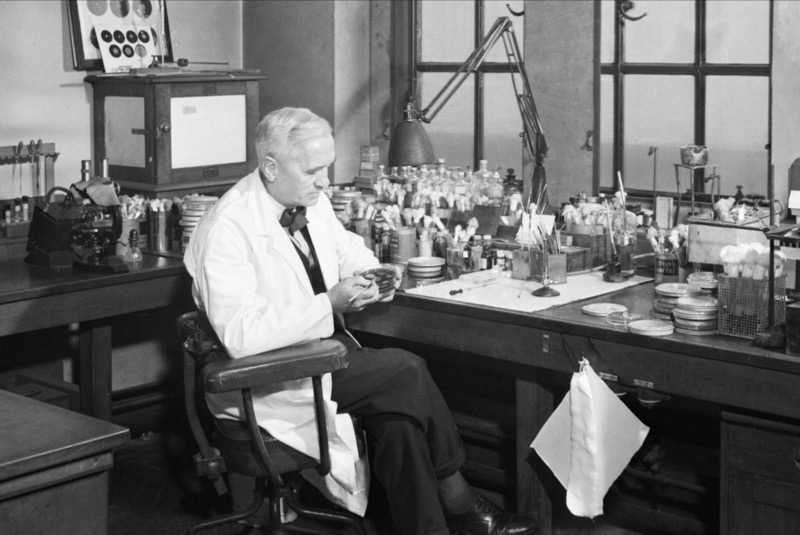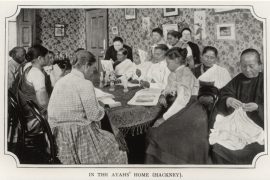In 1928, Alexander Fleming, Professor of Bacteriology at St. Mary’s Hospital in London, developed Penicillin, the first antibiotic, for which he received the Nobel Prize in Physiology or Medicine in 1945, along with Ernst Boris Chain and Sir Howard Walter Florey.
Penicillin, the first effective drug to fight diseases such as pneumonia, gonorrhoea, or rheumatic fever, ushered in the ‘antibiotic era.’ Before the discovery of Penicillin, hospitals were filled with patients afflicted by blood poisoning caused by a cut or a scrape.
Sir Alexander Fleming was born at Lochfield, near Darvel, Ayrshire, Scotland, on 6 August 1881. During World War I, Fleming served as a Captain in the Army Medical Corps, where he saw many of his fellow soldiers die, not from wounds sustained in battle but from infections.
At the time, antiseptics were used to control infections. However, they often caused more damage than good. Recording his observations, Fleming published an essay addressing the existence of anaerobic bacteria in deep wounds, which thrived despite antiseptics. Since then, Fleming had dedicated himself to searching for a remedy for bacterial infections.
As part of his research, Fleming kept bacterial cultures in bowls near his work table. In 1928, he spotted something odd in one of the dishes while sorting Petri dishes containing colonies of Staphylococcus, the bacterium which causes boils, sore throats, and abscesses.
The colonies formed by bacteria spotted the entire dish, except for one spot where a glob of mould was developing. The area immediately around the mould was clear as if the mould had released something that had stopped bacteria from growing. The ‘mould juice,’ which he later called Penicillin, could kill harmful bacteria.
Stuart Craddock and Frederick Ridley, Fleming’s assistants, were tasked with separating pure Penicillin from mould juice. It turned out to be very unstable, and they could only deal with rudimentary material solutions.
In June 1929, Fleming published the results of his findings in the British Journal of Experimental Pathology, but Penicillin’s medical potential was just a fleeting mention. However, the practical use of the new substance tickled the interest of the bacteriologists.
Many attempted to purify the substance and isolate pure Penicillin but failed until researchers Ernst Boris Chain and Sir Howard Walter Florey conducted research at Oxford University. Their work on the purification and chemistry of Penicillin started in 1939, just as research became more challenging due to wartime circumstances.
The team needed to filter up to 500 litres of mould filtrate each week for animal testing and clinical trials. They started growing it in odd containers, including bathtubs, bedpans, milk churns, and food tins. Later, a bespoke fermentation vessel was created for ease of removal, to conserve space, and to replenish the broth under the mould’s surface.
They hired a crew of ‘penicillin girls’ for £2 per week to inoculate and care for the fermentation; the Oxford University laboratory was effectively transformed into a Penicillin factory.
In 1940, Florey demonstrated that Penicillin could protect mice from fatal Streptococci infection. Finally, on 12 February 1941, Albert Alexander, a forty-three-year-old police officer, became the first to receive the Oxford penicillin.
While trimming roses, Albert, the policeman, scraped the side of his mouth, resulting in a life-threatening illness with massive abscesses damaging his eyes, face, and lungs. He was given Penicillin and made a miraculous recovery within days. However, he did not survive as the supply of the drug ran out.
The researchers carried on with their trials. With additional cases came better outcomes, and thus, preparations were quickly made to make Penicillin accessible to British soldiers on the battlefield.
In Britain, large-scale Penicillin manufacturing was out of the question as the chemical industry was engaged in the war effort. So, in the Summer of 1941, Florey and his colleague Norman Heatley went to the United States with the assistance of the Rockefeller Foundation to see if they could persuade the American pharmaceutical industry to join the attempt to mass-produce Penicillin.
Despite Florey’s disappointment with the trip’s immediate results, three firms—Merck, Squibb, and Lilly—had undertaken penicillin research. The project became a major source of inventions that enabled large-scale penicillin manufacturing.
It also enabled further research into the Penicillin extraction methods and sparked a worldwide hunt for improved penicillin-producing strains. The most prolific type came from a rotting cantaloupe purchased from a Peoria fruit store.
But there was one problem. At the time, Penicillin’s promise was still based on a small number of clinical studies. Florey received assistance from the Office of Scientific Research and Development’s Committee on Medical Research (CMR), which was established to ensure research on scientific and medical security-related issues.
Businesses were informed that the federal government might help if they began penicillin production as it would serve the public interest. So, Pfizer established the first commercial facility for large-scale penicillin synthesis in Brooklyn, New York, on 1 March 1944. Clinical trials in both the military and civilian sectors confirmed Penicillin’s medicinal potential.
Streptococcal, staphylococcal, and gonococcal infections responded well to the medication, and the discovery of Penicillin was called the ‘single greatest victory ever achieved over disease.’ In addition to the Nobel Prize, Fleming received a knighthood in honour of his achievements in 1944.
-30-
Copyright©Madras Courier, All Rights Reserved. You may share using our article tools. Please don't cut articles from madrascourier.com and redistribute by email, post to the web, mobile phone or social media.Please send in your feed back and comments to [email protected]











